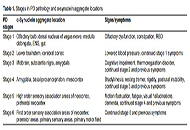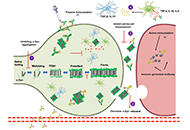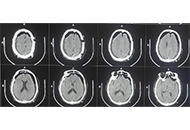Targeting α-synuclein aggregation with immunotherapy: a promising therapeutic approach for Parkinson’s disease
Parkinson’s disease (PD) is a prevalent neurodegenerative disease (NDD) affecting millions of individuals. The pathogenesis of PD centers around α-synuclein (α-Syn), a pivotal protein whose aggr
[...] Read more.
Parkinson’s disease (PD) is a prevalent neurodegenerative disease (NDD) affecting millions of individuals. The pathogenesis of PD centers around α-synuclein (α-Syn), a pivotal protein whose aggregation significantly impacts disease progression. Although existing treatments mainly focus on managing motor symptoms by targeting the dopaminergic system, they frequently overlook other non-motor symptoms. The intricate nature of PD pathogenesis contributes to challenges in disease analysis and has hindered the development of effective PD treatments. In recent years, various novel therapies utilizing immunotherapy methods have exhibited promise in preclinical animal models. In NDDs, immunotherapy aims to counteract the detrimental effects of protein accumulation by neutralizing toxic species and aiding their elimination. Numerous active therapy (AI) and passive immunotherapy (PI) strategies have been devised for PD and related synucleinopathies, many of which are currently undergoing clinical trials. Despite demonstrating remarkable success in animal models, immunotherapies encountered substantial setbacks during the late stages of clinical trials, with the exception of lecanemab, which targets amyloid-β (Aβ) in Alzheimer’s disease (AD) and has recently received approval from the Food and Drug Administration (FDA). The lack of translation from experimental investigations to successful clinical outcomes, particularly in terms of cognitive and functional evaluations, highlights the limitations of relying solely on animal studies to comprehend the effects of immunotherapeutic approaches. This comprehensive review focuses on α-Syn-based immunotherapies and delves into their underlying mechanisms of action. Furthermore, Furthermore, the article discusses recent advancements and future prospects concerning the potential of immunotherapeutic strategies for PD. The focus is on highlighting the latest research in this domain to illuminate the challenges and opportunities related to the development of efficacious immunotherapies for individuals with PD.
Gabriela Henriquez, Mahesh Narayan
Parkinson’s disease (PD) is a prevalent neurodegenerative disease (NDD) affecting millions of individuals. The pathogenesis of PD centers around α-synuclein (α-Syn), a pivotal protein whose aggregation significantly impacts disease progression. Although existing treatments mainly focus on managing motor symptoms by targeting the dopaminergic system, they frequently overlook other non-motor symptoms. The intricate nature of PD pathogenesis contributes to challenges in disease analysis and has hindered the development of effective PD treatments. In recent years, various novel therapies utilizing immunotherapy methods have exhibited promise in preclinical animal models. In NDDs, immunotherapy aims to counteract the detrimental effects of protein accumulation by neutralizing toxic species and aiding their elimination. Numerous active therapy (AI) and passive immunotherapy (PI) strategies have been devised for PD and related synucleinopathies, many of which are currently undergoing clinical trials. Despite demonstrating remarkable success in animal models, immunotherapies encountered substantial setbacks during the late stages of clinical trials, with the exception of lecanemab, which targets amyloid-β (Aβ) in Alzheimer’s disease (AD) and has recently received approval from the Food and Drug Administration (FDA). The lack of translation from experimental investigations to successful clinical outcomes, particularly in terms of cognitive and functional evaluations, highlights the limitations of relying solely on animal studies to comprehend the effects of immunotherapeutic approaches. This comprehensive review focuses on α-Syn-based immunotherapies and delves into their underlying mechanisms of action. Furthermore, Furthermore, the article discusses recent advancements and future prospects concerning the potential of immunotherapeutic strategies for PD. The focus is on highlighting the latest research in this domain to illuminate the challenges and opportunities related to the development of efficacious immunotherapies for individuals with PD.
 Rehabilitation for non-motor symptoms for patients with Parkinson’s disease from an α-synuclein perspective: a narrative reviewOpen AccessReviewParkinson’s disease (PD) is a common neurodegenerative disorder affecting aged population around the world. PD is characterized by neuronal Lewy bodies present in the substantia nigra of the midbr [...] Read more.Zhaoyang Liu ... Wen LiuPublished: August 27, 2023 Explor Neuroprot Ther. 2023;3:235–257
Rehabilitation for non-motor symptoms for patients with Parkinson’s disease from an α-synuclein perspective: a narrative reviewOpen AccessReviewParkinson’s disease (PD) is a common neurodegenerative disorder affecting aged population around the world. PD is characterized by neuronal Lewy bodies present in the substantia nigra of the midbr [...] Read more.Zhaoyang Liu ... Wen LiuPublished: August 27, 2023 Explor Neuroprot Ther. 2023;3:235–257 Targeting α-synuclein aggregation with immunotherapy: a promising therapeutic approach for Parkinson’s diseaseOpen AccessReviewParkinson’s disease (PD) is a prevalent neurodegenerative disease (NDD) affecting millions of individuals. The pathogenesis of PD centers around α-synuclein (α-Syn), a pivotal protein whose aggr [...] Read more.Gabriela Henriquez, Mahesh NarayanPublished: August 25, 2023 Explor Neuroprot Ther. 2023;3:207–234
Targeting α-synuclein aggregation with immunotherapy: a promising therapeutic approach for Parkinson’s diseaseOpen AccessReviewParkinson’s disease (PD) is a prevalent neurodegenerative disease (NDD) affecting millions of individuals. The pathogenesis of PD centers around α-synuclein (α-Syn), a pivotal protein whose aggr [...] Read more.Gabriela Henriquez, Mahesh NarayanPublished: August 25, 2023 Explor Neuroprot Ther. 2023;3:207–234 Retracted: Diffusion magnetic resonance imaging-based surrogate marker in amyotrophic lateral sclerosisOpen AccessReviewAmyotrophic lateral sclerosis (ALS) is the most prevalent type of motor neuron disease (MND) and is diagnosed with a delay from the first appearance of symptoms. Surrogate markers that may be used t [...] Read more.Yuya SaitoPublished: August 25, 2023 Explor Neuroprot Ther. 2023;3:186–206
Retracted: Diffusion magnetic resonance imaging-based surrogate marker in amyotrophic lateral sclerosisOpen AccessReviewAmyotrophic lateral sclerosis (ALS) is the most prevalent type of motor neuron disease (MND) and is diagnosed with a delay from the first appearance of symptoms. Surrogate markers that may be used t [...] Read more.Yuya SaitoPublished: August 25, 2023 Explor Neuroprot Ther. 2023;3:186–206 Tension pneumocephalus as a complication of surgical evacuation of chronic subdural hematoma: case report and literature reviewOpen AccessCase ReportThe management of symptomatic chronic subdural hematoma (CSDH) is surgical evacuation and prognosis in most cases is good. Tension pneumocephalus is the presence of air under pressure in the intracr [...] Read more.Mohammed A. Azab ... Brandon Lucke-WoldPublished: August 23, 2023 Explor Neuroprot Ther. 2023;3:177–185
Tension pneumocephalus as a complication of surgical evacuation of chronic subdural hematoma: case report and literature reviewOpen AccessCase ReportThe management of symptomatic chronic subdural hematoma (CSDH) is surgical evacuation and prognosis in most cases is good. Tension pneumocephalus is the presence of air under pressure in the intracr [...] Read more.Mohammed A. Azab ... Brandon Lucke-WoldPublished: August 23, 2023 Explor Neuroprot Ther. 2023;3:177–185